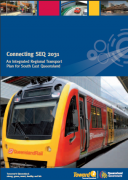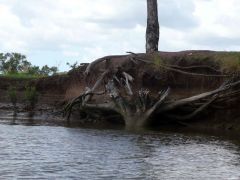
Logan and Albert Conservation Association

NOTHING IS PROTECTED along corridor for section of
INLAND RAIL Calvert - Acacia Ridge ARTC 2017/7944
prepared by Ted Fensom of Wildlife Qld and BREC - Brisbane Region Environment Council
This could involve clearing of about 500 hectares of koala and fauna habitat and near natural grasslands without any clarity on a range of sustainable fauna outcomes. This clearing could increase for each of haul roads, access roads, dumps, lay down areas, cuttings and depots. A combined EIS under
A combined EIS under bilaterals is proposed. The Coordinator General's Terms of Reference COG's TOR is yet to come out. See EPBC 2017/7944- controlled action documents
The Acacia Ridge to Port of Brisbane rail mentioned in Senate estimates is still a matter of State- Federal negotiations.
Tunnels proposed at Woollamin are Woollamin 1 length of 1.1 km and Woollamin 2 200 metres. Information on the Ebenezer crossing is needed
Vegetation will be remapped for Regional Ecosystems, but that does not necessarily disclose High Value Regrowth, Old Growth, Rare and Threatened Species or classification of near natural grasslands or Biodiversity Hotspots under CNCCS or SEQB BPA .
 The Queensland Government's Connecting SEQ 2031 transport plan unveils a sustainable transport vision for the next 20 years - according to Transport Minister Annastacia Palaszczuk and Main Roads Minister Craig Wallace.
The Queensland Government's Connecting SEQ 2031 transport plan unveils a sustainable transport vision for the next 20 years - according to Transport Minister Annastacia Palaszczuk and Main Roads Minister Craig Wallace.
This draft document which informed the PARK RIDGE CONNECTOR CORRIDOR Community Stakeholders Reference Group discussions was annouced as policy just before 'whole' community consulation began on the PARK RIDGE CONNECTOR CORRIDOR.
Clearly this proposed new motorway extending south the Gateway Motorway and join the Logan Motorway - both toll roads - the proposed motorway will be a tollroad.
To download a copy of Connecting SEQ 2031, visit the project website at www.connectingseq.qld.gov.au
Connecting SEQ 2031 has established targets for Logan City Council local government area that aim to:
• increase the public transport share of trips from 5.5% in 2006 to 10% in 2031
• increase the share of walking trips from 8.1% in 2006 to 10% in 2031
• increase the share of cycling trips from 0.6% in 2006 to 7% to 2031
• decrease the share of trips by private vehicles from 85.8% to 73%.

Following the release on Wednesday November 20 of the Healthy Waterways Ecosystem Health Report, in which the Albert and Logan Rivers each received fails for the second year in a row, general agreement has emerged within LACA and among other conservation groups across the region that the situation for this river/bay system is now critical and requires urgent new attention, NOT business as usual.
Continuation alone of the strategies put in place by SEQ Catchments and Healthy Waterways and responsible NRMs clearly will not provide the genuine on the ground, full system solutions that are now desperately needed. Their strategies, while clearly aimed at long term outcomes, have nevertheless been in place for ten years during which the rivers and bay areas in SE Qld have steadily declined, with the Logan/Albert/Southern Bay the worst performing system in
The need for a ‘Crisis
LACA members and others have expressed the view that urgent action is needed at a government/legislative level. To explore this and hopefully arrive at a collective decision, a ‘crisis summit’ on the rivers and bay has been proposed, to be held possibly in February 2011. As a ‘summit’ this will differ from the Logan City Council proposal for a ‘forum’. While a ‘forum’ usually involves open community access and input of ideas ending in a summary report, a ‘summit’ involves the key players and decision makers in a process of dialogue and collective decision making for action. However, the summit could take on board the information that might flow out of an earlier ‘forum’, so the two proposals are not necessarily mutually exclusive.
This issue encompasses the whole catchment area of the Logan and Albert Rivers, and as such includes the impacts on the system of major new development proposals including those at Flagstone, Yarrabilba, Bahrs Scrub and Bromelton. Accordingly, a ‘crisis summit’ would involve key decision makers from Federal, State and local government, landholders groups, Agforce, conservation groups, developers in the region, river based industry groups such as prawn farmers, tourism and amateur and professional fishing organisations. The starting point for the crisis summit should be the collective understanding that there is a ‘crisis’ in this system and that genuine new actions, possibly involving legislation, are needed in order to prevent the ecological and physical collapse of the river/bay system.
 What is TRAIN? It is an acronym standing for TRANS REGIONAL AMALGAMATED INFRASTRUCTURE NETWORK and the project is termed Nation Building Australia Project 1.0 TRAIN. Information about this business network is available on the website http://www.nationbuildingaustralia.com.au/root/index.html
What is TRAIN? It is an acronym standing for TRANS REGIONAL AMALGAMATED INFRASTRUCTURE NETWORK and the project is termed Nation Building Australia Project 1.0 TRAIN. Information about this business network is available on the website http://www.nationbuildingaustralia.com.au/root/index.html
TRAIN is a network of road, rail and water infrastructure servicing the Great South West, an area covering approximately 197,710 ha of regional Australia. The Great South West stretches south for 377km from Logan in Southern Queensland to Coffs Harbour in northern New South Wales, and 189km west from Warwick in southern Queensland to Lismore in Northern New South Wales.
The August 2009 document claims TRAIN CREATES REGIONAL JOBS AND GROWTH that will unlock the productive potential of the constrained primary industries in northern New South Wales and southern Queensland - create new industry and business opportunities in southern Queensland and northern New South Wales - open the Bromelton State Development Area's 16,000 ha of employment generating land with the capacity to suppor t 31,000 jobs by 2051.
Or you can search the archives here